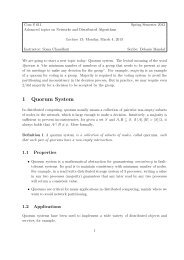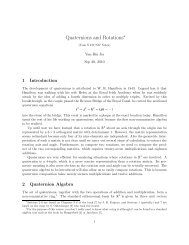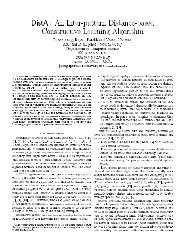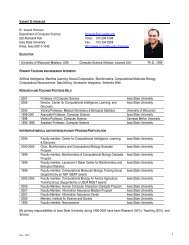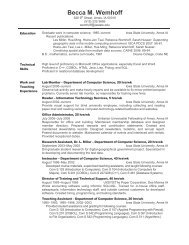Geocasting in Mobile Ad Hoc Networks: Location-Based ... - CiteSeerX
Geocasting in Mobile Ad Hoc Networks: Location-Based ... - CiteSeerX
Geocasting in Mobile Ad Hoc Networks: Location-Based ... - CiteSeerX
You also want an ePaper? Increase the reach of your titles
YUMPU automatically turns print PDFs into web optimized ePapers that Google loves.
lower rate of <strong>in</strong>crease than multicast flood<strong>in</strong>g. This is because,<br />
with scheme 1, number of multicast packets transmitted<br />
is reduced by limit<strong>in</strong>g data broadcast<strong>in</strong>g to a smaller<br />
forward<strong>in</strong>g zone.<br />
Figure 7 plots the results for scheme 2. Figure 7(a) shows<br />
that the location-based multicast scheme 2 is generally more<br />
accurate than scheme 1 (See Figure 6(a)). However, note<br />
that the accuracy for schemes 1 and 2 both is comparable<br />
with that of the multicast flood<strong>in</strong>g, when = 150 units. Similar<br />
to scheme 1, amount of multicast data delivery overhead<br />
for the multicast flood<strong>in</strong>g algorithm <strong>in</strong>creases much<br />
more rapidly than scheme 2, when transmission range is <strong>in</strong>creased.<br />
The effect of vary<strong>in</strong>g the size of forward<strong>in</strong>g zone<br />
is also shown <strong>in</strong> Figure 7.<br />
5 Optimizations of <strong>Location</strong>-<strong>Based</strong> Multicast<br />
A number of optimizations are possible to improve performance<br />
of the basic location-based multicast protocols 5 .<br />
5.1 Alternative Def<strong>in</strong>itions of Forward<strong>in</strong>g Zone<br />
In this paper, we consider two ways of def<strong>in</strong><strong>in</strong>g a forward<strong>in</strong>g<br />
zone. Several other alternatives may be considered.<br />
For <strong>in</strong>stance, <strong>in</strong> the scheme 1, the sides of the rectangle are<br />
always parallel to the X and Y axes. It is possible to remove<br />
this restriction when def<strong>in</strong><strong>in</strong>g the rectangular region.<br />
For example, one side of the rectangle may be made parallel<br />
to the l<strong>in</strong>e connect<strong>in</strong>g the location of source node S to the<br />
geometric center of the multicast region (see Figure 8).<br />
5.2 Forward<strong>in</strong>g Zone <strong>Ad</strong>aptation<br />
In our location-based multicast scheme 1, the forward<strong>in</strong>g<br />
zone is specified explicitly by the source S, and it is not<br />
modified by any <strong>in</strong>termediate nodes. By adapt<strong>in</strong>g the forward<strong>in</strong>g<br />
zone at any <strong>in</strong>termediate node I, the performance<br />
of the scheme 1 can be improved. For example, <strong>in</strong> Figure<br />
9(a), when node I receives the multicast data packet<br />
from the source S and forwards the packet to its neighbors<br />
because I is with<strong>in</strong> the forward<strong>in</strong>g zone Z (def<strong>in</strong>ed by S), it<br />
can replace Z by an adapted forward<strong>in</strong>g zone Z’ before forward<strong>in</strong>g<br />
the packet. By apply<strong>in</strong>g the same reason<strong>in</strong>g when<br />
node J receives the data packet from node I, the forward<strong>in</strong>g<br />
zone can be aga<strong>in</strong> adapted.<br />
Generaliz<strong>in</strong>g the above idea, although a rectangular<br />
shape is used for the forward<strong>in</strong>g zone <strong>in</strong> location-based multicast<br />
scheme 1, any other form may also be used. For<br />
<strong>in</strong>stance, Figure 9(b) shows the case when the forward<strong>in</strong>g<br />
zone is def<strong>in</strong>ed as a cone rooted at node S, such that angle<br />
5Most optimization approaches proposed for the LAR <strong>in</strong> [15, 17] can<br />
also be applied here.<br />
8<br />
Accuracy of Delivery ( % )<br />
Total Number of Multicast Packets Received Per Multicast<br />
100<br />
90<br />
80<br />
70<br />
60<br />
50<br />
40<br />
Multicast Flood<strong>in</strong>g<br />
Scheme 2 (delta = 150)<br />
Scheme 2 (delta = 100)<br />
Scheme 2 (delta = 50)<br />
Scheme 2 (delta = 0)<br />
30<br />
200 250 300<br />
Transmission Range of Nodes (units)<br />
350 400<br />
300<br />
250<br />
200<br />
150<br />
100<br />
50<br />
(a) Accuracy of Multicast Delivery<br />
Multicast Flood<strong>in</strong>g<br />
Scheme 2 (delta = 150)<br />
Scheme 2 (delta = 100)<br />
Scheme 2 (delta = 50)<br />
Scheme 2 (delta = 0)<br />
0<br />
200 250 300<br />
Transmission Range of Nodes (units)<br />
350 400<br />
(b) Total Number of Multicast Packets Received Per<br />
Multicast<br />
Figure 7. <strong>Location</strong>-<strong>Based</strong> Multicast Scheme<br />
2 (For 30 nodes, and Average speed 2.5<br />
units/sec) : (a) Delivery accuracy versus<br />
Transmission range, (b) Total number of multicast<br />
packets received per multicast versus<br />
Transmission range



